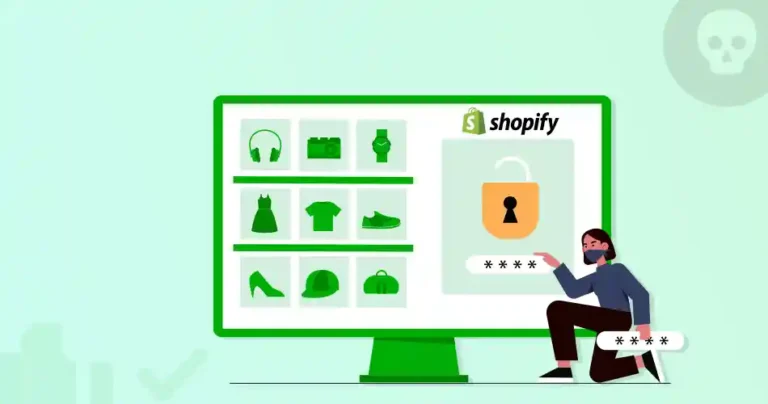According to recent reports, the global eCommerce fraud detection and prevention market was worth over $58 billion in 2024. As online shopping grows, so do fraud risks. Fake transactions, chargebacks, and stolen identities can harm businesses and erode customer trust.
Shopify gives merchants tools to fight fraud, but Shopify expert developers can take your security to the next level. They help spot scams, reduce chargebacks, and keep your store safe. Whether it’s Shopify’s built-in fraud checks or advanced apps, the proper setup protects your business.
This guide will show you how Shopify’s tools—and expert help—can secure your store, simplify operations, and keep customers happy. Let’s get started!
Recognizing and Mitigating Fraud in Shopify Stores
Fraud is a common challenge for eCommerce businesses, including those using Shopify. Understanding the various types of fraud and their warning signs is the first step toward effective prevention.
Common Types of Fraud in eCommerce
- Chargeback Fraud: Customers dispute actual transactions, claiming they didn’t approve the purchase. They often receive a refund while keeping the product—leading to costly Shopify fraud chargeback losses for merchants.
- Identity Theft: Fraudsters steal credit card info to make unauthorized purchases. This leads to chargebacks for merchants.
- Account Takeover: Hackers steal customer accounts. They use saved payment info to make fake orders. Shopify fraud protection.
Warning Signs of Fraudulent Activity
- Mismatched Information: Orders where the billing and shipping addresses don’t match.
- High-Risk Orders: Large or bulk purchases from new or unverified accounts.
- Repeated Payment Failures: Multiple failed attempts to process payment, often with different cards.
- High-Risk IPs: Transactions originating from known high-risk regions or using proxy IP addresses.
Recognizing these signs early is essential to preventing fraud and maintaining the trust of your customers. Using strong detection tools and strategies can significantly lower your risks and protect your Shopify store.
Strategies for Fraud Prevention on Shopify
Shopify offers strong tools to help merchants prevent fraud. These built-in features protect businesses from fraudulent activities.
These tools keep customer data safe and lower financial losses. This helps create a secure and easy shopping experience for everyone.
Below is an in-depth look at Shopify’s key fraud prevention features:
Fraud analysis
Shopify’s Fraud Analysis tool uses intelligent algorithms and machine learning to spot suspicious orders. This feature provides merchants with actionable insights, enabling informed decision-making before fulfilling orders. Key aspects of the Fraud Analysis tool include:
- Billing and Shipping Address Issues: We mark orders where the billing and shipping addresses don’t match. This can show possible fraud.
- Multiple Failed Payment Attempts: If payment attempts fail several times, it may point to fraud. This can lead the system to flag those transactions as high-risk.
- High-Risk Location Orders: Orders from areas with a lot of fraud are flagged for review.
Each order is assigned a risk level—low, medium, or high—based on these factors. Merchants can use this information to decide whether to process, investigate, or cancel an order. factors. Merchants can use this information to decide whether to process, investigate, or cancel an order.
Shopify Payments Protection
Shopify Payments offers merchants extra security through its chargeback protection program. This feature helps merchants handle the costs of fraud. It covers eligible chargebacks, easing their financial burden. Benefits of Shopify Payments Protection include:
- Chargeback Cost Coverage: Shopify covers the financial loss from eligible chargebacks. This gives merchants peace of mind.
- Simplified Dispute Process: The tool makes resolving disputes easier, saving merchants time and effort.
Two-Factor authentication (2FA)
Shopify provides Two-Factor Authentication (2FA) for admin accounts. This is an important security measure for eCommerce. By requiring an additional verification step during login, 2FA significantly reduces the risk of unauthorized access. Key benefits of enabling 2FA include:
- Better Account Security: To log in, users need access to a secondary method, such as a mobile device or an authentication app.
- Protection Against Phishing Attacks: Even if your login info gets stolen, 2FA helps keep out intruders.
Customer Account Features
Encouraging customers to create accounts on your Shopify store can add another layer of security. Shopify employs advanced security measures to protect customer accounts, such as:
- Password Encryption: We encrypt customer passwords to stop unauthorized access if there’s a data breach.
- Session Monitoring: Shopify keeps an eye on customer account sessions. It looks for suspicious activities like many login attempts from strange devices or places.
- Easy Account Recovery: Customers can safely reset passwords or get back into their accounts if there are any problems.
Why Fraud Prevention Matters
Fraudulent transactions lead to financial losses. They can also hurt a brand’s reputation and weaken customer trust. Shopify’s tools make fraud detection easy. This lets merchants grow their business while keeping security strong.
Merchants can use these features to offer a safe shopping experience. This helps protect their profits, too.
One of the critical parts of our professional Shopify development services is fraud prevention. So you can hire our services and can take care of the security issues effectively.
Advanced Fraud Prevention with Shopify Apps
Shopify’s App store provides powerful tools to strengthen your store’s fraud prevention efforts. Popular options include:
- FraudBlock: Automatically cancels orders flagged as high-risk by Shopify’s Fraud Analysis.
- Signifyd: Covers chargebacks for fraudulent transactions with a 100% guarantee on approved orders.
- NoFraud: Offers real-time fraud screening and ensures smooth order processing.
- SEON: Leverages machine learning to detect suspicious patterns and prevent fraud effectively.
These apps guard your store against fraud. They also ensure a safe and smooth shopping experience for your customers.
How to Reinforce Fraud Prevention on Shopify
Shopify’s fraud prevention tools offer strong protection. However, using them with proactive practices boosts security even more. Here are key steps to enhance your store’s fraud defence:
- Check Orders Often: Look at flagged orders for issues like wrong addresses, large quantities, or multiple orders from the same IP.
- Use Address Verification System (AVS): Ensure billing addresses match those on file with the card issuer to minimize fraud risks.
- Enable CVV Checks: CVV verification is required during checkout to confirm the customer has physical access to their card.
- Set Up Shipping Restrictions: Limit shipping to high-risk regions or use apps to block suspicious IPs.
- Implement Strong Password Policies: Encourage strong, unique passwords and enable password strength indicators.
- Educate Your Team: Train staff to spot signs of fraud, such as unusual behavior or mismatched order details.
By combining Shopify’s tools with these practices, you can build a more secure store and reduce the risk of fraudulent transactions. Want to implement these practices? Then, hire Shopify developers from our team to get the best results.
How to Handle Fraudulent Transactions on Shopify?
Even with preventive measures in place, fraudulent transactions may still occur. Here’s how to manage them effectively:
Investigate Suspicious Orders
Before processing high-risk orders, reach out to the customer to verify their details. You can use email or phone to confirm their information.
Respond to Chargebacks Promptly
If you face a chargeback, respond quickly by providing clear evidence, such as:
- Shipping confirmation and tracking numbers
- Communication logs with the customer
Refund Carefully
If you suspect fraud, issue a refund rather than fulfilling the order. This helps reduce potential losses while protecting your store.
By taking these steps, you can manage fraudulent transactions and minimize their impact on your business.
Let’s Wrap Up
Fraud prevention isn’t just a one-time job. It’s a lasting promise to keep your Shopify store, your customers, and your income safe.
Using Shopify’s tools, like Fraud Analysis and chargeback protection, can help you lower the risks of fraud. Integrating advanced apps for enhanced security and following best practices such as AVS checks and CVV verification will also help.
Want help with fraud prevention on Shopify? Then, let’s have a consultation today!
FAQs on Fraud Prevention in Shopify
Q1. How can I identify fraudulent transactions on my Shopify store?
Check for signs like mismatched billing and shipping addresses, unusual or large orders, and failed payment attempts. Shopify’s Fraud Analysis tool can help flag suspicious transactions.
Q2. Can Shopify's built-in tools completely prevent fraud?
Shopify’s tools work well, but using extra apps and best practices gives better fraud protection.
Q3. What are chargebacks, and how do I deal with them?
Chargebacks occur when customers dispute transactions. You can contest them by providing order details, shipping confirmations, and communication logs.
Q4. How do I ensure my customers' data is secure?
Enable Two-Factor Authentication (2FA) for admin accounts and encourage customers to use strong, unique passwords. Shopify encrypts customer data to protect against breaches.





